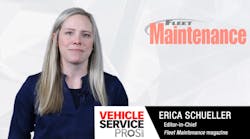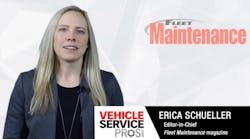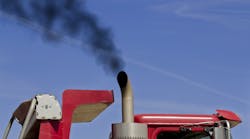Diesel engine emission systems have become more complex with the addition of diesel particulate filters (DPFs) and diesel oxidation catalysts (DOCs) to manage emissions output. These components play a crucial role in reducing emissions for a diesel engine. Jason Soika, Vice President of Sales for DuraFit discusses assessing a quality aftertreatment component, some misconceptions of “remanufactured” DPFs and DOCs, and expectations fleets should have for this product category.
Transcription of interview:
Erica Schueller, Fleet Maintenance: Welcome to VSP News: Uptime Update. I am your host Erica Schueller, Editor-in-Chief of Fleet Maintenance magazine, covering all maintenance, all management, all vehicle classes, all the time.
Diesel particulate filters, or DPFs, and diesel oxidation catalysts, also known as DOCs, play a crucial role in the aftertreatment system of a diesel engine to help reduce emissions.
DPF and DOC aftermarket aftertreatment products can provide an alternative option to original equipment components, while still offering similar quality and performance. But, there can sometimes be challenges with defining and assessing the performance of these aftertreatment products.
We talked with Jason Soika, Vice President of Sales for DuraFit, on the more widespread adoption of quality aftermarket aftertreatment products, and why aftermarket products are becoming more accepted as an alternative to a first fit product.
Jason Soika, DuraFit: First, awareness and education is key. DuraFit was recently acquired by AP Emission Technologies, which has given us a greater platform to get out and communicate to the customer base that aftermarket products do have a place in this market.
Consistent messaging about the performance and durability against that of the first-fit option is key. The DuraFit branded product has been in the marketplace since late 2014, and we’ve sold thousands of units, and proven its durability and performance in the aftertreatment product segment.
And, customers also like a single source for their product needs and service needs. DuraFit offers an all-makes, all-models comprehensive offering of aftertreatment components ranging from Class 2 to Class 8. That’s a convenience to any fleet operator in terms of finding a single source for their service parts.
Schueller, Fleet Maintenance: While aftermarket DPFs and DOCs are becoming more prevalent, Soika notes there is a difference between what might be called “remanufactured” aftermarket aftertreatment products, versus first-fit and aftermarket new replacement units.
Soika explains more.
Soika, DuraFit: Let’s first be clear about the term "remanufacturing" as it pertains to diesel particulate filters (DPFs) and diesel oxidation catalysts (DOCs). There is no such thing as a remanufactured DPF or DOC, it is simply a cleaned unit then remarketed as a lower-cost alternative to a new unit.
For a “reman” DPF or DOC, during the cleaning process, nothing is actually replaced in terms of componentry, it is simply cleaned.
As we know with viable remanufacturing programs, in order to be considered a certified remanufactured product, you have to replace componentry.
In addition, the “reman” solution is not quite as viable as it once was. The high fallout rate of defective cores is creating an availability issue for those programs. They cannot find usable cores to continue to clean and feed into the program.
That’s creating many of the remanufacturers to essentially abandon some of their offerings under the reman program.
Also, the cost associated with the core. Every reman unit sold, you have to pay not only a parts cost, but you also have a core charge, or bounty. When the core is defective or fails, that core bounty is called up, making it a very expensive situation for a customer.
We believe the new units, like a DuraFit DPF or DOC, is a better and more cost-effective solution long-term for a customer given its proven durability, proven performance and you have a known history of the core, because it’s a new unit.
Schueller, Fleet Maintenance: As we’re all aware, there has been an ever-greater push for products to be produced in the United States instead of overseas. Soika shares insights on the rationale and benefits for fleets looking to purchase substrate products in the U.S.
Soika, DuraFit: There is proven durability, performance and general risk avoidance by purchasing a new unit that utilizes an OE-grade substrate.
The low-cost country manufacturers are developing substrates that today, by OE standards, are not meeting the quality requirements. There are a lot of inconsistencies in the dimensionals, pores per square inch, etc. The things that really matter to the DPF or DOC.
These low-cost alternatives have been present in the marketplace for some time, and there is a customer base willing to assume the risk simply because the price of those units is less.
We believe the low-cost country manufacturers will at some point bring the quality of those substrates to the same expectations, and they will be qualified.
We are constantly testing those sources of substrates and trying to qualify them. There may be a day where that is a solution. But today, we believe in using the OE-grade sourced substrates to ensure the performance and durability our customers expect. This improves uptime for the operators of the equipment and gives them a level of confidence when they’re buying an aftermarket solution.
Schueller, Fleet Maintenance: Speaking of a focus on U.S-based manufacturing, with DuraFit’s recent acquisition by AP Emissions Technologies, the brand can focus on more vertical integration. Soika discusses more on this.
Soika, DuraFit: As a result of the recent acquisition of the DuraFit brand by AP Emissions Technologies, we are transitioning all the manufacturing and distribution of the DPFs and DOCs to Hobart, Indiana.
Within the Hobart, Indiana operations we have the ability to generate our catalysts, we do all the coating processes on site, and we also do all the final assembly and canning processes.
We are vertically integrating this product line into one operation so we have complete control. Essentially what we do is buy a substrate, bring it into Hobart, and on the other end we produce a turnkey product for our customers.
This gives us great confidence in quality control, supply control and delivery to our customers.
Schueller, Fleet Maintenance: For more information on exhaust and emission aftertreatment systems, and maintenance guidelines on those systems, check out the link below.
Thank you for tuning in to VSP News Uptime Update, I’m your host Erica Schueller.
Until our next broadcast, keep up with this, and other industry topics, by visiting us online at VehicleServicePros.com.
Find out more about exhaust and emission aftertreatment systems.


